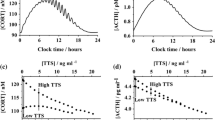Abstract
A continuous-time, discrete-state stochastic model of testosterone secretion in men is considered. Blood levels of testosterone in men fluctuate periodically with a period of 2–3 h. The deterministic model, on which the stochastic model considered here is based, is well studied and has been shown to have a globally stable fixed point. Thus, no sustained oscillations are possible in the deterministic case. However, the stochastic model does observe periodic, pulsatile behavior. This demonstrates how oscillations can occur due to a switching behavior dependent on the random degradation of testosterone molecules in the system. The Gillespie algorithm is used to simulate the hormone secretion model. Important parameters of the model are discussed and results from the model are compared to experimental observations.
Similar content being viewed by others
References
Becker, K.L. (Ed.), 2001. Principles and practice of endocrinology and metabolism, 3rd edition. Lippincott, Williams, and Wilkins, Philadelphia.
Cartwright, M., Husain, M., 1986. A model for the control of testosterone secretion. J. Theor. Biol. 123, 239–250.
Elowitz, M.B., Levine, A.J., Siggia, E.D., Swain, P.S., 2002. Stochastic gene expression in a single cell. Science 297, 1183–1186.
Enciso, G., Sontag, E.D., 2004. On the stability of a model of testosterone dynamics. J. Math. Biol. 49, 627–634.
Gillespie, D.T., 1976. A general method for numerically simulating the stochastic time evolution of coupled chemical reactions. J. Comput. Phys. 22, 403–434.
Gillespie, D.T., 1977. Exact stochastic simulation of coupled chemical reactions. J. Phys. Chem. 81, 2340–2361.
Goodwin, B.C., 1965. Oscillatory behavior in enzymatic control processes. Adv. Enzyme Regul. 3, 425–438.
Hormone. Encyclopedia Britannica, 2004. Encyclopedia Britannica Online: http://www.search.eb.com/eb/article?tocId=72724.
Keenan, D.M., Veldhuis, J.D., 1998. A biomathematical model of time-delayed feedback in the human male hypothalamic-pituitary-Leydig cell axis. Am. J. Physiol. 275, E157–E176.
Keenan, D.M., Sun, W., Veldhuis, J.D., 2000. A stochastic biomathematical model of the male reproductive hormone system. SIAM J. Appl. Math. 61, 934–965.
Linstrom, P.J., Mallard, W.G. (Ed.), 2003. NIST Chemistry WebBook, NIST Standard Reference Database Number 69. National Institute of Standards and Technology, Gaithersburg, MD. Online: http://webbook.nist.gov.
Martin, C.R., 1985. Endocrine Physiology. Oxford University Press, New York.
Murray, J.D., 2002. Mathematical Biology I: An Introduction, 3rd edition. Springer, New York.
Naftolin, F., Judd, H.L., Yen, S.S.C., 1973. Pulsatile patterns of gonadotropins and testosterone in man: The effects of clomiphene with and without testosterone. J. Clin. Endocrinol. Metab. 36, 285–288.
Press, W.H., Teukolsky, S.A., Vetterling, W.T., Flannery, B.P., 1992. Numerical recipes in C: The art of scientific computing, 2nd edition. Cambridge University Press, Cambridge.
Qian, H., Saffarian, S., Elson, E.L., 2002. Concentration fluctuations in a mesoscopic oscillating chemical reaction system. PNAS 99, 10376–10381.
Raser, J.M., O’Shea, E.K., 2004. Control of stochasticity in eukaryotic gene expression. Science, 304, 1811–1814.
Shoelson, B., 2001. lombscargle.m. MATLAB Central File Exchange. Online: http://www.mathworks.com/matlabcentral/fileexchange/loadFile.do?objectId=993objectType=file.
Smith, W.R., 1980. Hypothalamic regulation of pituitary secretion of luteinizing hormone. II Feedback control of gonadotropin secretion. Bull. Math. Biol. 42, 57–78.
Vilar, J.M.G., Kueh, H.Y., Barkai, N., Leibler, S., 2002. Mechanisms of noise-resistance in genetic oscillators. PNAS 99, 5988–5992.
World Health Organization Expert Committee on Biological Standardization, 1989. Thirty-ninth Report. WHO Technical Report Series No. 786.
Yen, S.S.C., Jaffe, R.B., Barbieri, R.L., 1999. Reproductive Endocrinology: Physiology, Pathophysiology, and Clinical Management, 4th edition. Saunders, Philadelphia.
Author information
Authors and Affiliations
Corresponding author
Rights and permissions
About this article
Cite this article
Heuett, W.J., Qian, H. A Stochastic Model of Oscillatory Blood Testosterone Levels. Bull. Math. Biol. 68, 1383–1399 (2006). https://doi.org/10.1007/s11538-006-9098-4
Received:
Accepted:
Published:
Issue Date:
DOI: https://doi.org/10.1007/s11538-006-9098-4




